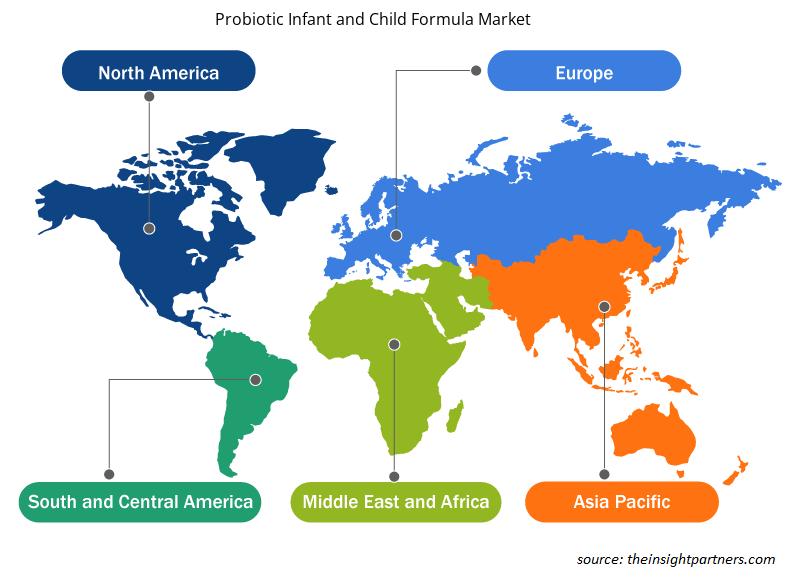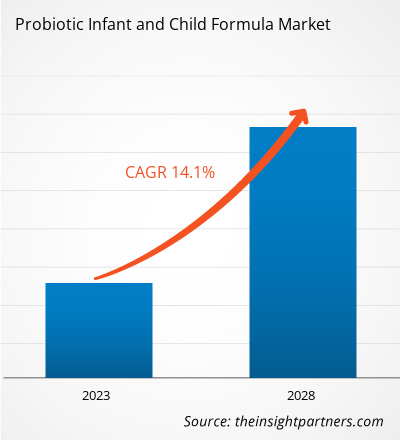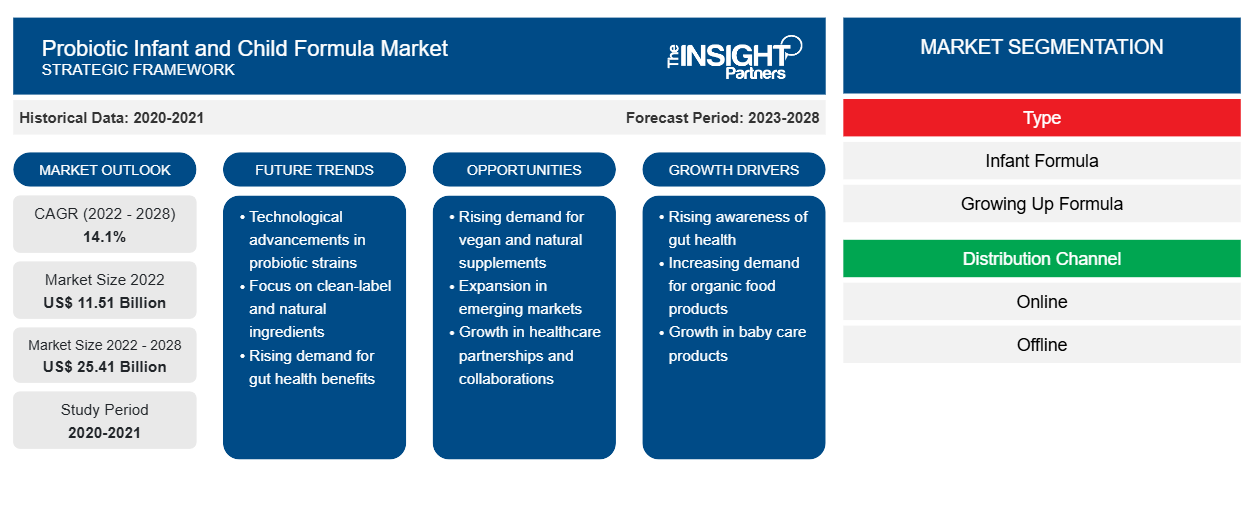Der Markt für probiotische Säuglings- und Kindernahrung soll von 11.505,28 Millionen US-Dollar im Jahr 2022 auf 25.412,41 Millionen US-Dollar im Jahr 2028 wachsen; von 2022 bis 2028 wird mit einer durchschnittlichen jährlichen Wachstumsrate von 14,1 % gerechnet.probiotic infant and child formula market is expected to grow from US$ 11,505.28 million in 2022 to US$ 25,412.41 million by 2028; it is estimated to grow at a CAGR of 14.1% from 2022 to 2028.
Probiotische Säuglings- und Kindernahrung ist ein technisch hergestelltes Nahrungsmittel, das als Alternative zur Muttermilch verwendet werden kann. Diese Nahrung gehört zu den komplexesten Nahrungsmitteln, da sie anspruchsvolle Qualitätssicherungsprotokolle und spezielle Herstellungskapazitäten erfordert. Der Markt für probiotische Säuglings- und Kindernahrung erlebt aufgrund der steigenden Bevölkerung ein erhebliches Wachstum. Darüber hinaus förderte das steigende verfügbare Einkommen der Menschen im asiatisch-pazifischen Raum die Akzeptanz probiotischer Säuglings- und Kindernahrung. Auch die schnelle Urbanisierung und das Wachstum der Mittelschicht haben das Marktwachstum vorangetrieben. Die wachsende Zahl junger berufstätiger Mütter hat die Nachfrage nach probiotischer Säuglings- und Kindernahrung erhöht, da sie in hohem Maße von Säuglings- und Kindernahrungsprodukten abhängig sind.
Passen Sie diesen Bericht Ihren Anforderungen an
Sie erhalten kostenlos individuelle Anpassungen an jedem Bericht, einschließlich Teilen dieses Berichts oder einer Analyse auf Länderebene, eines Excel-Datenpakets sowie tolle Angebote und Rabatte für Start-ups und Universitäten.
-
Holen Sie sich die wichtigsten Markttrends aus diesem Bericht.Dieses KOSTENLOSE Beispiel umfasst eine Datenanalyse von Markttrends bis hin zu Schätzungen und Prognosen.
Nach einer Schätzung des US Census Bureau beträgt die Zahl der Kinder unter fünf Jahren im Jahr 2022 etwa 24,8 Millionen und wird bis 2030 voraussichtlich auf 25,2 Millionen anwachsen. Daher wird erwartet, dass die steigende Zahl der Kinder unter sechs Jahren die Nachfrage nach probiotischer Säuglings- und Kindernahrung steigern wird.
Markteinblicke
Steigende Zahl berufstätiger Frauen treibt Marktwachstum für probiotische Säuglings- und Kindernahrung an
Viele Frauen kehren nach der Entbindung schnell in ihren Beruf zurück. Daher sind Produkte wie Säuglingsanfangsnahrung ideal für berufstätige Frauen, da sie einfach zuzubereiten sind und weniger Zeit in Anspruch nehmen. Darüber hinaus hat Säuglingsanfangsnahrung verschiedene Nährwerte, wie menschliche Muttermilch, was ihre Akzeptanz bei den Verbrauchern erhöht. Daher ist die steigende Zahl berufstätiger Frauen ein wichtiger Faktor, der die Nachfrage nach probiotischer Säuglings- und Kindernahrung ankurbelt. China ist einer der größten Märkte für probiotische Säuglings- und Kindernahrung. China hat seine jahrzehntealte Ein-Kind-Politik 2016 abgeschafft. Die chinesische Regierung gab im Mai 2021 eine Ankündigung heraus, wonach Paare bis zu drei Kinder haben dürfen, nachdem Volkszählungsdaten einen starken Rückgang der Geburtenraten zeigten. Dieser Anstieg der Geburten wird voraussichtlich zu einer steigenden Nachfrage nach probiotischer Säuglings- und Kindernahrung führen. Es hat einen Paradigmenwechsel im Kaufverhalten der Verbraucher in Bezug auf Säuglingsanfangsnahrung gegeben, wobei Eltern Premium- und Ultra-Premium-Säuglingsanfangsnahrung gegenüber herkömmlicher Nahrung bevorzugen. Dieser Trend wird sich voraussichtlich fortsetzen und das Wachstum des Marktes für probiotische Säuglings- und Kindernahrung vorantreiben.probiotic infant and child formula. China is one of the biggest markets for probiotic infant and child formula. China scrapped its decades-old one-child policy in 2016 2016. The Chinese government made an announcement in May 2021, allowing couples to have up to three children after census data showed a sharp decline in birth rates. This surge in births is expected to lead to the growth in demand for probiotic infant and child formula. There has been a paradigm shift in consumers' buying behavior toward infant formula, with parents showing a preference for premium and ultra-premium infant formulas over conventional formulas. This trend is expected to continue and propel the growth of the probiotic infant and child formula market.
Typ-Einblicke
Der Markt für probiotische Säuglings- und Kindernahrung ist nach Typ in Säuglingsnahrung (0-1 Jahr) und Wachstumsnahrung (1-6 Jahre) unterteilt. Im Jahr 2021 dominierte das Segment Wachstumsnahrung (1-6 Jahre) den Markt.probiotic infant and child formula market is segmented into infant formula (0-1 year) and growing-up formula (1-6 years). In 2021, the growing-up formula (1-6 Years) segment dominated the market.
Nestlé SA; HiPP GmbH & Company Vertrieb KG; Abbott Laboratories; Mead Johnson & Company, LLC.; und Bellamy's Organic gehören zu den wichtigsten Akteuren auf dem Markt für probiotische Säuglings- und Kindernahrung. Die führenden Akteure verfolgen verschiedene Strategien, wie Fusionen und Übernahmen sowie Produkteinführungen, um ihre geografische Präsenz und Kundenbasis zu erweitern. S.A.; HiPP GmbH & Company Vertrieb KG; Abbott Laboratories; Mead Johnson & Company, LLC.; and Bellamy's Organic are among the key players operating in the probiotic infant and child formula market. The leading players adopt several strategies, such as mergers & acquisitions and product launches, to expand their geographic presence and consumer base.
Regionale Einblicke in den Markt für probiotische Säuglings- und Kindernahrung Infant and Child Formula Market Regional Insights
Die regionalen Trends und Faktoren, die den Markt für probiotische Säuglings- und Kindernahrung während des Prognosezeitraums beeinflussen, wurden von den Analysten von Insight Partners ausführlich erläutert. In diesem Abschnitt werden auch die Marktsegmente und die Geografie für probiotische Säuglings- und Kindernahrung in Nordamerika, Europa, im asiatisch-pazifischen Raum, im Nahen Osten und Afrika sowie in Süd- und Mittelamerika erörtert.Probiotic Infant and Child Formula Market throughout the forecast period have been thoroughly explained by the analysts at Insight Partners. This section also discusses Probiotic Infant and Child Formula Market segments and geography across North America, Europe, Asia Pacific, Middle East and Africa, and South and Central America.

- Erhalten Sie regionale Daten zum Markt für probiotische Säuglings- und Kindernahrung
Umfang des Marktberichts über probiotische Säuglings- und Kindernahrung
| Berichtsattribut | Details |
|---|---|
| Marktgröße im Jahr 2022 | 11,51 Milliarden US-Dollar |
| Marktgröße bis 2028 | 25,41 Milliarden US-Dollar |
| Globale CAGR (2022 - 2028) | 14,1 % |
| Historische Daten | 2020-2021 |
| Prognosezeitraum | 2023–2028 |
| Abgedeckte Segmente |
Nach Typ
|
| Abgedeckte Regionen und Länder |
Nordamerika
|
| Marktführer und wichtige Unternehmensprofile |
|
Marktteilnehmerdichte für probiotische Säuglings- und Kindernahrung: Auswirkungen auf die Geschäftsdynamik verstehen
Der Markt für probiotische Säuglings- und Kindernahrung wächst rasant. Dies wird durch die steigende Nachfrage der Endverbraucher aufgrund von Faktoren wie sich entwickelnden Verbraucherpräferenzen, technologischen Fortschritten und einem größeren Bewusstsein für die Vorteile des Produkts vorangetrieben. Mit der steigenden Nachfrage erweitern Unternehmen ihr Angebot, entwickeln Innovationen, um die Bedürfnisse der Verbraucher zu erfüllen, und nutzen neue Trends, was das Marktwachstum weiter ankurbelt.
Die Marktteilnehmerdichte bezieht sich auf die Verteilung der Firmen oder Unternehmen, die in einem bestimmten Markt oder einer bestimmten Branche tätig sind. Sie gibt an, wie viele Wettbewerber (Marktteilnehmer) in einem bestimmten Marktraum im Verhältnis zu seiner Größe oder seinem gesamten Marktwert präsent sind.
Die wichtigsten Unternehmen auf dem Markt für probiotische Säuglings- und Kindernahrung sind:
- Nestlé SA
- HiPP GmbH & Company Vertrieb KG
- Abbott Laboratories
- Mead Johnson & Company, LLC.
- Bellamy's Bio
Haftungsausschluss : Die oben aufgeführten Unternehmen sind nicht in einer bestimmten Reihenfolge aufgeführt.

- Überblick über die wichtigsten Akteure auf dem Markt für probiotische Säuglings- und Kindernahrung
Bericht-Spotlights
- Progressive Trends in der probiotischen Säuglings- und Kindernahrungsindustrie helfen den Akteuren bei der Entwicklung wirksamer langfristiger Strategien
- Von Unternehmen verfolgte Geschäftswachstumsstrategien zur Sicherung des Wachstums in entwickelten und sich entwickelnden Märkten
- Quantitative Analyse des globalen Marktes für probiotische Säuglings- und Kindernahrung von 2021 bis 2028
- Schätzung der Nachfrage nach probiotischer Säuglings- und Kindernahrung in verschiedenen Branchen
- Porters Fünf-Kräfte-Analyse zur Veranschaulichung der Wirksamkeit von Käufern und Lieferanten, die in der probiotischen Säuglings- und Kindernahrungsindustrie tätig sind
- Aktuelle Entwicklungen zum Verständnis der Wettbewerbssituation auf dem Markt und der Nachfrage nach probiotischer Säuglings- und Kindernahrung
- Markttrends und -aussichten in Verbindung mit Faktoren, die das Wachstum des Marktes für probiotische Säuglings- und Kindernahrung bestimmen
- Verständnis für die Strategien, die das kommerzielle Interesse im Hinblick auf das Marktwachstum untermauern, als Unterstützung im Entscheidungsprozess
- Marktgröße für probiotische Säuglings- und Kindernahrung an verschiedenen Marktknoten
- Detaillierte Übersicht und Segmentierung des Marktes sowie seiner Branchendynamik
- Marktgröße für probiotische Säuglings- und Kindernahrung in verschiedenen Regionen mit vielversprechenden Wachstumschancen
Die „Analyse probiotischer Säuglings- und Kindernahrung bis 2028“ ist eine spezialisierte und eingehende Studie der Lebensmittel- und Getränkeindustrie, die sich auf die Markttrendanalyse konzentriert. Der Bericht soll einen Überblick über den Markt mit detaillierter Segmentierung geben. Der Markt für probiotische Säuglings- und Kindernahrung ist nach Typ, Vertriebskanal und Geografie segmentiert. Basierend auf dem Typ ist der Markt in Säuglingsnahrung (0-1 Jahr) und Wachstumsnahrung (1-6 Jahre) segmentiert. Basierend auf der Verteilung ist der Markt für probiotische Säuglings- und Kindernahrung in Online und Offline segmentiert. Basierend auf der Geografie ist der Markt in vier Hauptregionen segmentiert: Nordamerika, Europa, Asien-Pazifik und Rest der Welt. Im Jahr 2021 dominierte der Asien-Pazifik-Raum den Markt für probiotische Säuglings- und Kindernahrung und wird im Prognosezeitraum voraussichtlich die höchste durchschnittliche jährliche Wachstumsrate auf dem Markt verzeichnen. Faktoren wie das zunehmende Bewusstsein für Ernährungsbedürfnisse und die steigende Geburtenrate im Asien-Pazifik-Raum trieben die Nachfrage nach probiotischer Säuglings- und Kindernahrung an.
- Historische Analyse (2 Jahre), Basisjahr, Prognose (7 Jahre) mit CAGR
- PEST- und SWOT-Analyse
- Marktgröße Wert/Volumen – Global, Regional, Land
- Branchen- und Wettbewerbslandschaft
- Excel-Datensatz
Aktuelle Berichte
Verwandte Berichte
Erfahrungsberichte
Grund zum Kauf
- Fundierte Entscheidungsfindung
- Marktdynamik verstehen
- Wettbewerbsanalyse
- Kundeneinblicke
- Marktprognosen
- Risikominimierung
- Strategische Planung
- Investitionsbegründung
- Identifizierung neuer Märkte
- Verbesserung von Marketingstrategien
- Steigerung der Betriebseffizienz
- Anpassung an regulatorische Trends























 Kostenlose Probe anfordern für - Markt für probiotische Säuglings- und Kindernahrung
Kostenlose Probe anfordern für - Markt für probiotische Säuglings- und Kindernahrung